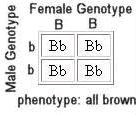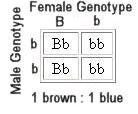 |
The sequence of the DNA base pairs for the brown eye and blue eye alleles (the bey2 gene) as shown in the right of the diagram is essentially similar except the one base pair A-T in the former is replaced by G-C in the latter. Homozygous refers to the case where the two alleles are identical; while heterozygous signifies the alleles have different forms. The allele expressed in the heterozygote is dominant; while the one not expressed is recessive. In the bey2 example, brown is dominant over blue unless it is damaged. In that case, the recessive allele takes over as the functional gene.
|




